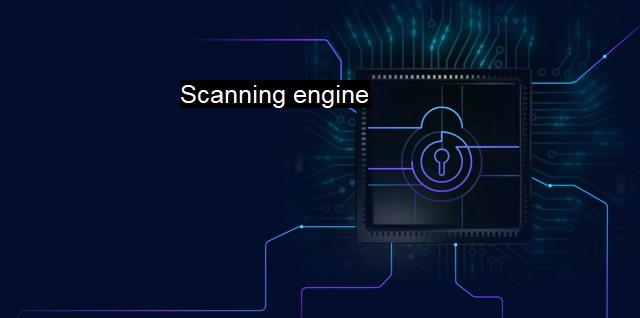What is Scanning engine?
The Importance of Scanning Engines in Cybersecurity: Protecting Your Computer System from Malware and Cyberattacks
A scanning engine is an important component of any antivirus software or cybersecurity system. It fundamentally operates by effectively looking for any malicious software, hazardous files, or suspicious behavior rendered by applications within a device or network. The scanning engine is typically programmed with a robust database of virus definitions and known intrusion techniques, facilitating accurate identification of potential threats.The necessity of scanning engines cannot be overemphasized in the digital world. With a continuous surge in sophisticated cyber threats and advanced persistent threats, no individual or organization wants to fall victim to damaging cyberattacks that can compromise critical data and halt business operations. By integrating a scanning engine into antivirus software or cybersecurity solutions, high-end security to avert such malicious intrusions can be provided.
A scanning engine performs two specific types of scans namely on-demand scanning and on-access scanning. On-demand scanning is a manual scan which the user has to initiate, usually scanning the entire computer or selected files. On the other hand, on-access scanning, sometimes referred to as real-time scanning, is automatic and happens in the background as and when files are accessed or opened. It ensures that any threats are caught immediately before they can infect the system.
Further enhancing its functionalities, some scanning engines rely on heuristics to identify new threats or variants of existing threats. Heuristics involve evaluating the behavior or attributes of files and applications to detect potentially harmful activity even if the threat has not been previously identified. This approach widens the threat detection spectrum of the engine, making it adaptive and dynamic to ever-evolving cyber threats.
Despite their effectiveness, one potential downside of scanning engines is that they can sometimes identify harmless software as malicious, known as false positives. While this is generally a rare occurrence, it can be annoying to users and may lead to legitimate software being deleted or quarantined. many antivirus programs allow users to 'whitelist' trusted files and programs, which reduces the chance of false positives.
a well-engineered scanning engine pairs the established library of known malicious code with constant heuristic analysis. This dual functionality automatically blocks any programs that show signs of potential threats and provides comprehensive protection against both known and emerging malware, from viruses and trojans to ransomware.
While the importance of a robust scanning engine is well contrasted, it is essential to note that it is just one component of a secure cybersecurity system. Supplemental security measures, such as consistent software patching, strong password protocols, two-factor authentication, and educated user behavior, should be integrated to support the operations of the scanning engine and provide a holistic cybersecurity approach.
The integrating scanning engine technology plays a crucial role in identifying and isolating malicious cyber threats in both software and hardware components of computing devices. Its significance is only set to increase as cyber threats become more sophisticated, given the continuous digital evolution and the loyalty to connectivity. Entrusting a cybersecurity solution with a high-level scanning engine could be the front-line weapon in the war against cybercrime, reassuring peace of mind concerning our data protection and confidentiality.
That said, the importance of routine upgrades to scanning engines, as well as their virus definition databases, cannot be overstated. It is the fuel that empowers these engines to function effectively, meeting every new cyberattack with a robust response. The reality is that a proactive security posture is crucial, and the abilities of a scanning engine – constantly updated and fine-tuned – provide precisely this defensive position in the landscape of growing cyber threats.

Scanning engine FAQs
What is a scanning engine in cybersecurity?
A scanning engine in cybersecurity refers to the software component of an antivirus program that is responsible for analyzing files and code within a computer or network to identify and remove any potential threats or malicious software.How does a scanning engine work in antivirus software?
A scanning engine works by analyzing the files and code within a computer or network for known malware signatures and suspicious behavior. It then quarantines or removes any identified threats to prevent them from causing harm. Scanning engines may also use heuristic analysis and machine learning algorithms to identify previously unknown threats.What are the benefits of using a scanning engine in antivirus software?
Using a scanning engine in antivirus software provides multiple benefits, including identifying and removing potential security threats before they can cause any harm, protecting personal and sensitive information from theft or damage, and preventing unauthorized access to computer systems and networks.Do all antivirus software programs use scanning engines?
Most antivirus software programs do use scanning engines, as it is a critical component of their cybersecurity offerings. However, the specific features and effectiveness of scanning engines may vary based on the software's brand, version, and subscription level.| | A | | | B | | | C | | | D | | | E | | | F | | | G | | | H | | | I | | | J | | | K | | | L | | | M | |
| | N | | | O | | | P | | | Q | | | R | | | S | | | T | | | U | | | V | | | W | | | X | | | Y | | | Z | |
| | 1 | | | 2 | | | 3 | | | 4 | | | 7 | | | 8 | | |||||||